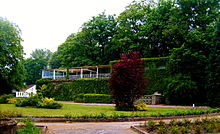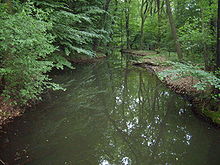Saathain Castle
The remains of Saathain Castle with the associated former manor are located on the left side of the Black Elster in Saathain , a district of the southern Brandenburg municipality of Röderland . After the historic building fell victim to a fire in April 1945, only the foundation walls remain, on which there is a terrace that was previously used as a café. The park that once belonged to the castle has been transformed into a rose garden and is a popular destination.
history

Saathain is one of the oldest fortifications on the Black Elster. The castrum Sathim was mentioned in a document as early as 1140 . The castle served to secure the river crossing at the nearby confluence of the Großer Röder, which at the same time represented the border to the neighboring Gau Nizizi and probably also to protect and control the military and trade routes that ran parallel to the Schwarzen Elster . About a kilometer down the river, on the opposite side of the estuary, was the fortified structure of the Würdenhain Castle, which was destroyed in the middle of the 15th century . In addition to Saathain, the towns of Stolzenhain , Schweinfurth , Reppis , Gröditz and Mühldorf, which was incorporated in Kröbeln in 1935, were part of the Saathain rulership . Together with Tiefenau , Elsterwerda , Frauenhain , Ortrand and Großenhain , the castle belonged to the Naumburg monastery as an imperial fief until the middle of the 14th century . In 1274, Bishop Meinherr von Naumburg left Saathain Palace to Heinrich the Illustrious for life. In 1276 the lending was extended to Heinrich's son Friedrich Clem and his descendants.
From 1348 the noble family von Köckritz resided in Saathain . The Köckritze stayed in Saathain until 1475 and they were followed by the Schleinitze . The Meissen noble family owned at that time, about 20 kilometers east location rule Mückenberg , which called Schleinitzweg was associated with Saathain. In Elsterwerda there is another street near the Biehla train station along the Węgliniec – Roßlau railway that bears this name. The Schleinitze, whose Meissen line expired with the death of Hermann Otto von Schleinitz in 1891, remained there until 1716. In that year Woldemar Freiherr von Löwendal , who had already acquired the Elsterwerda dominion to the east in 1708, acquired the Saathain and Mückenberg dominions. In 1727 he left Saathain to his wife, who sold this rule to Johann George von Einsiedel in 1748 . After his death, Saathain fell to his three children, who in 1761 agreed that Johann Georg Friedrich and the later Saxon cabinet minister Detlev Carl Graf von Einsiedel would receive the estate. The latter acquired half of his brother in the Saathain rule in 1777 and was henceforth its sole owner. He left Saathain to his son Detlev Graf von Einsiedel in 1794, but he sold the property after only two years.
In 1796 Saathain was sold to Daniel Gottfried Wilhelm Freiherr von Stutterheim and in 1798 to the Count of Solms . In the following years the castle and manor changed hands several times until it was passed to Hauptmann a. D. Bormann, whose family kept the property until the land reform in 1945.
Towards the end of the Second World War , the Saathainer Castle was destroyed in April 1945 by a deliberately set fire. The extensive archive with historical records and files, the art treasures stored in the castle and the old church registers of the neighboring villages of Würdenhain (with the entries of baptisms, weddings and funerals from 1655 to 1812) and Stolzenhain fell victim to the flames. The 587-hectare estate of the manor belonging to the castle was later divided up in the Soviet occupation zone as part of the land reform . 489.91 hectares were accounted for by a total of 281 people in the surrounding communities of Haida (72.83 hectares), Reichenhain (124.80 hectares), Saathain (181.33 hectares), Stolzenhain (30.11 hectares), Würdenhain (78, 80 ha) and Kröbeln (2.04 ha).
From 1972, part of the old manor park was converted into a rose garden with more than 70 types of roses and around 5000 rose bushes. The part on the other side of today's road to Elsterwerda is what remains of the old alluvial forests of the Black Elster. This primeval lowland forest remnant is characterized by an extensive presence of protected natural wood anemone from.
The burnt-out structure of the castle was largely removed. A terrace with a summer café was built on the remaining foundation walls. The management of this café was given up in 2008. In the meantime, their access has been blocked off permanently and given a sign that justifies the entry ban with “danger of collapse”.
Manor Church
The half-timbered building of the former Saathain manor church, dating from 1629, was built on the site of a castle chapel mentioned in a document in 1575. It received its present form in 1816 through renovation work. The church has been a listed building since 1968. After extensive renovation measures, it has been open to the public again since 1990. The church and the adjoining manor, which has now also been renovated, are one of the cultural centers of the community and the Elbe-Elster district , with numerous concerts and exhibitions . Since May 2006 the possibility has been offered to get married in the historic half-timbered church.
In front of the church there is a memorial stone for the pastor and local history researcher Wolfgang Bastian , who saved the church from further deterioration in the mid-1930s with renovation measures and who died in Torgau in 1942 during interrogation by the Gestapo.
In May 2004 a sculpture park was opened on a meadow directly behind the building. There you will find works by the Armenian artist Ararat Haydeyan, who has set up a studio and a gallery on the estate. The various art objects with names such as The Family , The Kiss or The Chancellor's Cushion are made of different materials.
Stone Chronicle
In front of the remains of the castle there is a monument in the castle park, inaugurated on July 6, 1958, in the form of an uncut granite boulder with the place name, an oak tree and a water lily, which is supposed to remind of the water-rich Röderwald in the area. Below you can read some chronological data from the development of the village of Saathain, which the then head of the Bad Liebenwerda district museum Karl Fitzkow made available. The memorial is an initiative to thank the former Mayor of Saathain, Heinz Drei 30, who headed the community from 1951 to 1990. In 1991, the German National Committee for Monument Protection awarded thirty the German Prize for Monument Protection , the highest award in this field in Germany.
literature
- Felix Hoffmann: Saathain has been located on the Röder for over 800 years . In: Working groups of the friends of nature and home of the German cultural association Bad Liebenwerda district (Hrsg.): Home calendar for the Bad Liebenwerda district . Print shop activist Bad Liebenwerda, Bad Liebenwerda 1957, p. 63-66 .
- Felix Hoffmann: The stone chronicle of Saathain . In: Working groups of the friends of nature and home of the German cultural association Bad Liebenwerda district (Hrsg.): Home calendar for the Bad Liebenwerda district . Print shop activist Bad Liebenwerda, Bad Liebenwerda 1960, p. 198-201 .
Web links
- Homepage of the Förderverein Gut Saathain e. V.
- Saathain district page on the Röderland community website
Individual evidence
- ↑ Existence 10536 Manor Saathain. Saxon State Archives , Main State Archives Dresden , accessed on November 29, 2014 .
- ↑ The place - for those interested. Gut-Saathain e. V., accessed on November 29, 2014 .
- ↑ Luise Grundmann, Dietrich Hanspach (author): Der Schraden. A regional study in the Elsterwerda, Lauchhammer, Hirschfeld and Ortrand area . Ed .: Institute for Regional Geography Leipzig and the Saxon Academy of Sciences in Leipzig. Böhlau Verlag, Cologne / Weimar / Vienna 2005, ISBN 3-412-10900-2 , p. 151-155 .
- ↑ Felix Hoffmann: The stone chronicle of Saathain . In: Working groups of the friends of nature and home of the German cultural association Bad Liebenwerda district (Hrsg.): Home calendar for the Bad Liebenwerda district . Print shop activist Bad Liebenwerda, Bad Liebenwerda 1960, p. 198-201 .
- ^ Heinz Kettmann: 39 years mayor in Saathain . In: Arbeitsgemeinschaft für Heimatkunde e. V. Bad Liebenwerda (Hrsg.): Home calendar for the old district of Bad Liebenwerda, the Mückenberger Ländchen, outskirts on Schraden and Uebigau-Falkenberg . No. 54 , 2002, ISBN 3-932913-22-1 , pp. 129-132 .
- ↑ Erhard Galle: Wolfgang Bastian - pastor, historian, author, victim of Nazi persecution, finished by the Gestapo and forgotten by posterity? In: Arbeitsgemeinschaft für Heimatkunde e. V. Bad Liebenwerda (Ed.): Local calendar - For the old district of Bad Liebenwerda, the Mückenberger Ländchen, the outskirts of the Schraden and Uebigau-Falkenberg . No. 58 . Gräser Verlag Großenhain OHG, 2010, ISBN 3-932913-08-6 , p. 297-306 .
- ↑ Erhard Galle: Pastor Wolfgang Bastian would be 100 years old on May 21! In: Official Journal for the City of Elsterwerda . No. 5/2006 . Elsterwerda 2006, p. 8/9 .
Coordinates: 51 ° 28 ' N , 13 ° 28' E





